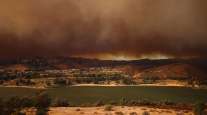Storm Moves On but Floodwaters Remain in Southern California

[Stay on top of transportation news: Get TTNews in your inbox.]
PALM DESERT, Calif. — Hilary, the first tropical storm to hit Southern California in 84 years, swept people into swollen rivers, toppled trees onto homes and flooded roadways as the massive system marched northward Aug. 21, prompting flood watches and warnings in more than a half-dozen states.
The National Hurricane Center in Miami downgraded Hilary to a post-tropical storm the morning of Aug. 21, but warned that “continued life-threatening and locally catastrophic flooding” was expected over portions of the southwestern U.S., along with record-breaking rainfall. There was the potential of flooding in states as far north as Oregon and Idaho. Remnants of the storm were expected to linger at least through the morning of Aug. 22.
Hilary, which first slammed into Mexico’s arid Baja California Peninsula, causing one death and widespread flooding, was one of several potentially catastrophic natural events affecting California on Aug. 20. Besides the tropical storm, which produced tornado warnings, there were wildfires and an earthquake. So far, no deaths, serious injuries or extreme damages have been reported in the state, though officials warned the risks remain, especially in the desert and mountainous regions because of swollen waterways and the wet hillsides that could unleash mudslides.
Winding roads in the San Bernardino Mountains east of Los Angeles were blocked by mud and debris flows. A stretch of the I-10 freeway near Palm Springs was also shut to traffic due to pooling water from the storm. Along the coast, a stretch of the Pacific Coast Highway in surf-friendly Huntington Beach was also flooded.

Terry and Jack Flanigan walk their dogs past a eucalyptus tree that fell on a condo Aug. 21 in Palm Desert, Calif. (Mark J. Terrill/Associated Press)
Terry Flanigan was inside her home in Palm Desert after taking pictures of the unusual rainfall when she heard a huge crash and then a deafening thud. Then she got a text from a neighbor who said a eucalyptus tree, more than 100 feet tall, had just fallen onto a condo across the street.
Flanigan, who called 911, later learned it landed on the bed of her neighbor’s 11-year-old son, who luckily was in another room.
“I’m sure they’re still terrified,” Flanigan said, adding that the mom and boy had gone to stay with relatives. “Removal crews came this morning and took off the branches, and it was very unnerving. Oh my gosh, what could have happened.”

Maura Taura surveys the damage caused by a downed tree outside her home in Sun Valley, Calif., after Tropical Storm Hilary went through Aug. 21. (Marcio Jose Sanchez/Associated Press)
Maura Taura felt a similar relief after a three-story-tall tree crashed down on her daughter’s two cars but missed the family’s house in the Sun Valley area of Los Angeles.
“Thank God my family is OK,” she said.
Warned about the potential dangers by emergency authorities, many residents hunkered down in their homes, leaving most freeways unusually clear of traffic jams Aug. 21.
Hilary is just the latest major weather or climate disaster to wreak havoc across the U.S., Canada and Mexico. Hawaii’s island of Maui is still reeling from a blaze that killed more than 100 people and ravaged the historic town of Lahaina, making it the deadliest U.S. wildfire in more than a century. Firefighters in Canada are battling that nation’s worst fire season on record.
NEW VIDEO:
Aftermath drone footage of #Hilary in Palm Springs, CA. Road closures are still expected today in Palm Springs. pic.twitter.com/5Wm6xHGSRq — WeatherNation (@WeatherNation) August 21, 2023
The storm dropped more than half an average year’s worth of rain on some areas, including Palm Springs, which saw more than 3 inches of rain by the evening of Aug. 20, shattering the previous record of 0.21 inches.
Aug. 20 was the wettest day on record in San Diego, with 1.82 inches, the National Weather Service said in a post on X, formerly known as Twitter. The previous record was on Aug. 17, 1977, when 1.8 inches of rain fell in the area post-Hurricane Doreen.
“We basically blew all of our previous rainfall records out of the water,” NWS meteorologist Elizabeth Adams in San Diego told The Associated Press.
The water rose knee-high in a homeless encampment along the rising San Diego River, where fire officials rescued 13 people. Farther north, crews pumped floodwaters out of the emergency room at Eisenhower Medical Center in Rancho Mirage.

Robbie Law uses a tractor to clear a neighbor's driveway in Yucaipa, Calif. (Marcio Jose Sanchez/Associated Press)
In the mountain community of Oak Glen, about 75 miles east of Los Angeles, Brooke Horspool worked to free a couple, including an elderly man with medical issues, from a house surrounded by about 4 feet of mud since a slide on Aug. 20.
“We have shovels and we’re going to go try and find a friend that has a Bobcat,” he said, referring to a brand of small earth-moving machines.
In the San Bernardino Mountains, about 800 residents were ordered to shelter in place Aug. 21 in the communities of Forest Falls, Oak Glen, Angelus Oaks and Seven Oaks because of mud blocking roads and driveways, said Cal Fire Battalion Chief Alison Hesterly. Work to clear the roads has been underway since late afternoon on Aug. 20.
I-10 at Thousand Palms finally starting to move westbound — shutdown from #Hilary floods and debris flows pic.twitter.com/CqfTDHceX0 — Rob Marciano (@RobMarciano) August 21, 2023
The center of Hilary passed over downtown Los Angeles at 7 p.m. Aug. 20, according to the regional weather office, which called it “a day for the ages” in Southern California.
“Los Angeles was tested but we came through it, and we came through it with minimal impacts considering what we endured,” City Council President Paul Krekorian said.
A tropical storm last roared into California in September 1939, ripping apart train tracks, tearing houses from their foundations and capsizing many boats. Nearly 100 people were killed on land and at sea.

Dorian Padilla sits in his car as he waits for a tow after it got stuck in the mud in Cathedral City, Calif. (Mark J. Terrill/Associated Press)
As Hilary moved east into the neighboring state of Nevada, flooding was reported, power was out and a boil-water order for about 400 households was issued in the Mount Charleston area, about 40 miles west of Las Vegas.
The only road in and out of Mount Charleston was washed out, and Nevada National Guard troops were sent into the area with trucks after a disaster declaration by Republican Gov. Joe Lombardo on Aug. 20. A shelter was opened for residents.
Forecasters said the threat for flooding in states farther north on Aug. 21 was highest across much of southeastern Oregon into the west-central mountains of Idaho. The forecast calls for potential thunderstorms and localized torrential rains on Aug. 22, said Jackson Macfarlane, a meteorologist with the weather service in Boise, Idaho.
Union Pacific crews continue to work around the clock to respond to the weather-related impacts of Hurricane Hilary on our rail network. Several trains are being held due to washouts and flood water throughout southern California. We are working to keep our customers informed. pic.twitter.com/Ckco4KvqBy — Union Pacific (@UnionPacific) August 21, 2023
In the Caribbean, meanwhile, Tropical Storm Franklin churned on Aug. 21 near Haiti and the Dominican Republic, where authorities warned residents to prepare for floods and landslides. Forecasters at the National Hurricane Center are also watching a disturbance in the Gulf of Mexico that now has an 80% chance of developing into a tropical disturbance or tropical storm before reaching the western Gulf coastline on Aug. 2.
By Mark J. Terrill, John Antczak and Julie Watson. Antczak reported from Los Angeles and Watson from San Diego. Associated Press reporters Ken Ritter in Las Vegas; Will Weissert in Washington; Freida Frisaro in Fort Lauderdale, Fla.; Curt Anderson in St. Petersburg, Fla.; Eugene Garcia in San Diego; Ryan Sun and Walter Berry in Phoenix, contributed to this report.
Want more news? Listen to today's daily briefing below or go here for more info:




